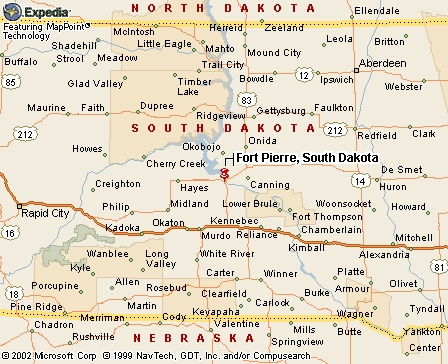|
|
Canku Ota |
|
|
(Many Paths) |
||
|
An Online Newsletter Celebrating Native America |
||
|
November 2, 2002 - Issue 73 |
||
|
|
||
|
Indian Students Study Heritage at Turner Ranch |
||
|
by Kevin Woster Argus
Leader
|
||
|
credits: art
Buffalo in Snow by John Nieto
|
 FORT
PIERRE,SD - On a grassy slope where buffalo can once again roam, Arayna
Bear Shields holds up the hollow black horn of the prairie beast that
once sustained her people. FORT
PIERRE,SD - On a grassy slope where buffalo can once again roam, Arayna
Bear Shields holds up the hollow black horn of the prairie beast that
once sustained her people.
"They used the buffalo horn for spoons and cups," the 11-year-old Lakota girl from Mission said. "They used the stomach for pots or to carry water. They used the buffalo for lots of things." "They" were her ancestors, the Lakota people who ruled the grasslands of the northern Great Plains before white civilization pushed them onto reservations and nearly exterminated the buffalo. Buffalo were at the center of Lakota culture, providing food and clothing and eating utensils, as well as spiritual strength and legend. Arayna already knew much of her tribal history from the teachings of her grandparents. But she and about 180 other students at the Pierre Indian Learning Center learned even more during a day at media mogul Ted Turner's Bad River Ranches. The Turner spread in South Dakota is a 140,000-acre consolidation of several ranch operations aimed at restoring native prairie and the wildlife species it once supported. Those species already include the buffalo, prairie dog and swift fox - a small fox that lives with and feeds on prairie dogs. It recently was reintroduced to the Turner property. The endangered black-footed ferret also could return to this landscape. The Turner operation must first build up sufficient numbers of prairie dogs to support the small ferrets. "In order to have ferrets, we need large expanses of prairie dogs," said Kevin Honness, a field biologist for Turner who specializes in swift fox reintroduction. "We are working toward that. It's a long road to get there." It's a relatively short road to the boundaries of the Turner ranches, about a mile south of Fort Pierre and six miles west on the dusty Bad River Road. That's the road that brought Arayna Bear Shields, her fellow students and their teachers from the Pierre Indian Learning Center on a breezy, chilly October day. The Native American children were guests at Bad River Ranches courtesy of Turner and the South Dakota Wildlife Federation. Federation Executive Director Chris Hesla of Pierre and his wife, Brenda, organized the one-day excursion to help Native American students experience the native prairie that is so much a part of their heritage. Hesla secured a $2,500 grant that paid for a noon lunch for the kids, as well as books on prairie ecology and spotting scopes for the school. "I thought this would be a good thing for them, to get out here and experience this place," Hesla said. "Many of them have had some tough times in their lives. Hopefully, this will be a positive for them." The day began with a blessing by a Native American medicine man, who also discussed the spiritual and healing powers of the buffalo, eagles and other native creatures. Children then were bused to different parts of the ranch for hands-on lessons in identifying native grasses and flowers and learning about the relationship between the land and its wildlife. Honness and other Turner employees helped teach the sessions, as did employees from the National Wildlife Federation, the South Dakota Game, Fish and Parks Department and the U.S. Forest Service. "We're talking about what makes a healthy prairie, what constitutes a good plant community out here," said Tony DeToy of the Forest Service office in Pierre. "Right around here, we're showing them prairie dropseed and coneflowers and side-oats grama." DeToy and Forest Service biologist Glenn Moravek hosted groups of students on a ridge near the east boundary of the Bad River Ranches. Nearby, Carolyn Greene of the National Wildlife Federation in Boulder, Colo., showed students a variety of native prairie pelts, grasses and flowers. Students immediately wrapped themselves in coyote pelts or draped badger or fox pelts over their heads, much as their ancestors might have done. It's that kind of touching and seeing that makes the day a valuable educational experience, said Veronica Pietz, teacher supervisor at the school. "For our kids, experiential learning seems to stick better than any kind of paper, pencil, textbook thing," Pietz said. "And of course, the cultural aspect is very important." The day was important to the Turner operation as well, Honness said. "It's a great opportunity to share what we're doing, to promote our programs and what we're trying to do here," Honness said. "And the kids get to see a working ranch that is protecting native wildlife and the prairie environment."
|
|
|
||
|
|
||
| Canku Ota is a free Newsletter celebrating Native America, its traditions and accomplishments . We do not provide subscriber or visitor names to anyone. Some articles presented in Canku Ota may contain copyright material. We have received appropriate permissions for republishing any articles. Material appearing here is distributed without profit or monetary gain to those who have expressed an interest. This is in accordance with Title 17 U.S.C. section 107. | ||
|
Canku Ota is a copyright © 2000, 2001, 2002 of Vicki Lockard and Paul Barry. |
||
 |
 |
|
|
The "Canku Ota - A Newsletter Celebrating Native America" web site and its design is the |
||
|
Copyright © 1999, 2000, 2001, 2002 of Paul C. Barry. |
||
|
All Rights Reserved. |
||
